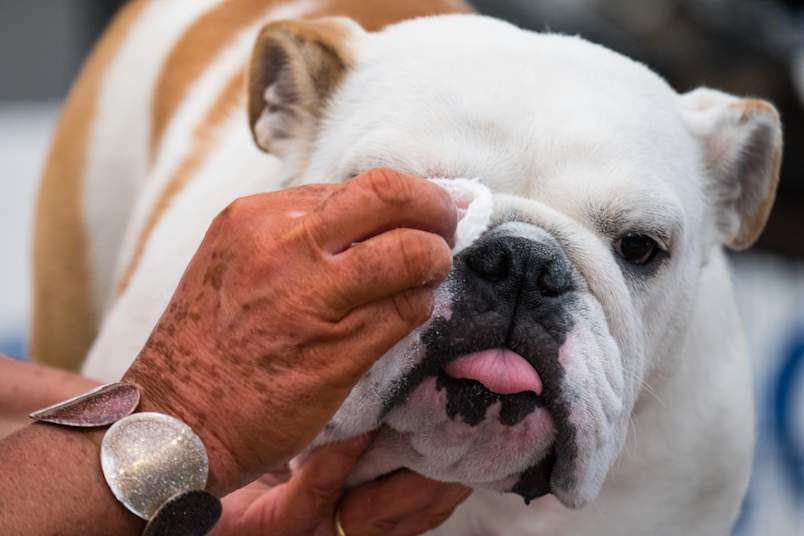
Wrinkles were once your pup's crowning glory, a source of endless amusement and snuggles. Now, those same folds seem like a breeding ground for discomfort and, well, let's just say, a less-than-pleasant odor. Cuddles turn into wrinkle investigations, and forget belly rubs – one whiff and you’re looking for an air freshener.
If your cuddle-loving pup has become an itchy, less-than-fragrant friend, it might be skin fold dermatitis. Skin fold dermatitis, a common condition in dogs with excessive skin folds, can cause inflammation, infection, and discomfort if left untreated.
But don’t worry, there's an answer to this common condition. First, you’ll need to understand why it’s happening, and then, more importantly, how to get your pup back to cuddle-ready condition. Let's get those wrinkles healthy again and get back to what truly matters: showering our furry companions with love.
What is Skin Fold Dermatitis?
Skin fold dermatitis, also known as skin fold pyoderma or intertrigo, happens when moisture, bacteria, and yeast get trapped in your dog's skin folds, causing irritation and infection. In pets already predisposed to skin fold dermatitis, obesity will exacerbate the condition. Underlying skin diseases, such as allergies, will also aggravate the condition, often severely. If you suspect that weight or allergies are a concern, consider making some dietary changes.
If you notice redness, hairless patches, bad smell, moistness, inflammation, sores, or signs of pain in your dog's skin folds, and you think it might be skin fold dermatitis, it's important to take them to the vet for a proper diagnosis and treatment plan.Your vet may perform skin scrapings or cytology to identify the specific bacteria or yeast involved and guide treatment decisions.
Breeds Prone to Skin Fold Dermatitis
While any dog with deep skin folds can get skin fold dermatitis, some breeds are more likely to develop the condition, such as English Bulldogs, French Bulldogs, Pugs, Shar Peis, and Basset Hounds. Though not a genetic disease per se, conformations that yield deep skin folds are often selectively bred for in certain dog breeds. While these features are considered desirable from an aesthetic standpoint, they can contribute to health issues like skin fold dermatitis. This raises ethical concerns about prioritizing aesthetics over the well-being of animals.
Treating and Managing Skin Fold Dermatitis
If your vet diagnoses your dog with skin fold dermatitis, they'll work with you to create a treatment plan. This might include cleaning the affected areas with vet-approved solutions, using medicated wipes or creams, giving oral antibiotics or antifungal medications for more severe cases, and in some cases, surgery to remove excess skin folds.
Treating any underlying skin disease and achieving weight loss will many times reduce the severity or even eliminate skin fold dermatitis.Your vet can help you develop a weight loss plan for your dog that includes a balanced diet and appropriate exercise. Addressing obesity not only improves skin fold dermatitis but also benefits your dog's overall health and quality of life.
The Role of Pet Insurance
Treating skin fold dermatitis can be expensive, especially if your pup needs long-term medication or surgery. This is where dog health insurance can be a lifesaver. Accident and illness policies often cover the costs of medications, surgeries, and other treatments related to skin fold infections. An optional pet wellness plan can help you budget for preventative measures, such as medicated wipes or solutions for cleaning skin folds, and even for prescription food to lose weight or help with allergies.
But remember, you have to enroll your pup in pet insurance before any signs of skin fold dermatitis appear. If you wait until your dog is already showing symptoms, the condition may be considered a pre-existing condition and not be covered by insurance. By enrolling your furry friend early, you can ensure that you have financial support if skin fold dermatitis or other health issues arise.
Treatment for skin fold dermatitis can cost anywhere from $30 to $50 per month for medications and cleaning supplies. If surgery is necessary, the cost can range from $500 to $2,500, depending on the severity and location of the affected area. With pet insurance, you can significantly reduce these expenses and focus on getting your pup the care they need.
Preventing Skin Fold Dermatitis
The best way to deal with skin fold dermatitis is to prevent it from happening in the first place. Clean your dog's skin folds daily with a soft cloth or cotton ball, using only vet-approved cleaning solutions.Be sure to dry the folds thoroughly after cleaning to prevent moisture buildup.
Keeping your dog at a healthy weight can also help reduce the depth of their skin folds, making them less likely to develop infections. If your dog has any underlying skin conditions, like allergies, managing these can also help prevent skin fold dermatitis.
Regular vet check-ups are essential for catching skin fold dermatitis early and preventing it from becoming a more serious problem. Your vet can also provide guidance on proper skin fold care and recommend products that are safe and effective for your dog's specific needs.
A Happy, Healthy Future for Your Wrinkly Pup
While skin fold dermatitis can be a challenge, with the right care and attention, your wrinkly pup can live a happy, comfortable life. By working with your vet, keeping your dog's skin folds clean and dry, and maintaining a healthy weight, you can help prevent skin fold dermatitis and keep your furry friend's skin healthy. With a little love and care, you'll be back to enjoying those snuggle sessions in no time!